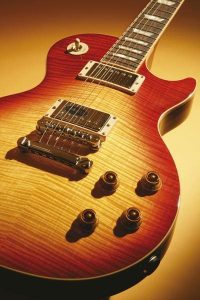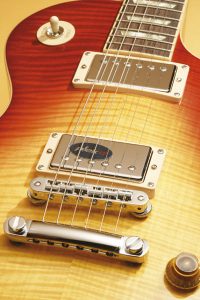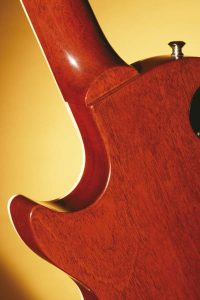Review
Table of Contents
The Standard isn’t standard any more. It’s lighter, has an all-new neck shape, and subtle additions that make it world-tour practical right out of the box. Gibson Les Paul Standard 2008Odd, isn’t it, that the Standard – not the Custom, or Deluxe, or any of the other attractively-named variants – has become the holy grail in Les Paul terms. ‘Standard’, of course, was the name that was first given to the humbucking sunburst Les Paul when it superseded the gold top Les Paul Model in 1958.
The incredible ‘bursts were only built for a couple of years, and when the company started making Les Pauls again in 1968 the Standard inexpicably returned in a less-desirable format with P90s. It wasn’t until 1976 that the Standard was available again with full-sized humbuckers and a cherry sunburst, and in the days of super-heavy ‘pancake’ bodies, it wasn’t much cop.
By the mid-’80s,though, Gibson was taking the Standard seriously once more, reaching a peak, some might argue, with the last of the Braz-board models a few years ago. Today, though, the whole is-it-a-real-Standard question has raised its head once more – because, in truth, the current Les Paul Traditional with its solid body, Kluson-style tuners, ’57 Classic pickups and fitted pickguard is a more accurate successor. In contrast,the 2008 Les Paul Standard addresses a number of supposed limitations,aiming to make it a traditional Les Paul for the 21st century.
Gibson Les Paul Standard Design
So where do we start? Pickguards are out of fashion right now, and the absence of a guard is the first thing you notice when you open the plush case. To my eye the heritage cherry sunburst is a little gaudy, but there are a number of more subtle shades on offer plus an ebony finish and a gold top. The next most obvious feature is also about an absence – of weight. The one-piece mahogany body is substantially chambered, a feature designed to enhance resonance and sustain.
Certainly, this is the most important move away from ’58 specs. It’s good news for the shoulder and back, and the acoustic tone is bright,zingy and loud in a way that makes many solid LPs sound muted. The AA-grade two-piece maple cap is nicely figured but not that well bookmatched, so the grain across the join is a little out of alignment.
The single-ply body binding is faultlessly installed but I do wish Gibson would stop using this particular shade of fawn. It doesn’t look like an aged white, it doesn’t match the colour of pickup covers, and it looks dirty against the stark white of the bone nut – for the binding extends fully up the sides of the rosewood fingerboard and covers the fret ends.
Advantages
Binding has the advantage of eliminating the possibility of any sharp tangs developing (usually caused by shrinkage of the fretboard over time) and also reduces the need for hand-finishing during set up. Talking of set up, the 2008 Standard is one of the first Gibsons to be Plek’d pre-sale. The Plek is a computer-controlled machine designed to do perfect set ups by micro-dressing the frets and adjusting the nut.
The list of new features goes on: circuit board-mounted gold-plated Bourns potentiometers for tone and volume (visible through the transparent control cavity cover), locking Grover tuners, a Neutrik locking jack socket, Dunlop strap locks, and a longer neck tenon for enhanced resonance and sustain. Gibson Les Paul Standard 2008
Most exciting of all is a brand new asymmetrical neck profile designed to be thicker on the bass side and thinner on the treble in order to fit the human hand better. Playing this guitar is a little strange at first because we’re so used to the classic, chubby ’50s-style neck carve and the ’60s slim taper; this neck makes you think of both at the same time.
Ergonomic
After the initial strangeness subsides, the new ergonomic profile is extremely likeable. It still feels chunky in that genuine Les Paul way but it’s particularly welcome for barré chord playing. Swinging into, say, a four-finger major 7th shape feels more comfy than usual, and there are plenty more chords where the same applies.
Equally, the G, B and top E strings seem a little easier to articulate for bluesy lead work when wrapping your hand round the neck rather than pivoting off the thumb, and you can’t fail to notice how good the action and intonation are and the fact that the instrument is total buzz-free. Plek’ing, it seems,really does deliver the goods.
Sounds
Pickups, especially humbuckers, don’t always accurately reproduce the acoustic tone of an electric guitar. With some guitars the colour of the pickups actually represents the instrument’s signature sound, with the woody characteristic running in second place to add character and nuance. Good news: the Burstbucker Pro pickups on the Les Paul 2008 Standard sound exceptionally transparent.
Designed specifically for the Gibson Les Paul Standard in 2002, they’re based on the PAF model with Alnico V magnets but the bridge is overwound to add balance and give more drive, while the neck unit is slight underwound for better clarity.
To my ear both pickups sound far less coloured than most original PAFs I’ve experienced, but they do share that rather charming, slightly microphonic character which is a guarantee that, with the right amp, you’ll get that wonderful front-edge pick attack that’s so much a part of the Les Paul appeal. All three selector positions deliver excellent open voices which work well for blues, country, rock and jazz.
Volume
The volume control has a more even gradient than usual, while clarity and treble is retained at minimal volume settings. However, it’s the hi-fi character of the tone control that really impresses. You can fine-tune your sound by minute degrees, so it’s a thumbs-up for those Bourns pots.
Gibson Les Paul Standard 2008 is fully at home with overdrive, too, and pulls off all the classic tones with ease. Some players will feel the need to ease back a little on the amp’s treble because there’s more top on tap than Les Pauls traditionally deliver.
The bridge pickup screams beautifully and the guitar sustains all day when you wind things up. Big chords chug along with steam train authority: basically, this guitar makes you feel like the boss. The extra high-end clarity also means that effects retain a better sense of integrity, so subtle blends are that much easier to set up and discern in the overall mix.
Gibson Les Paul Standard Verdict
This is an excellent guitar and yes, I could put up with the colour of the binding if I had to. While 1599 is a bit of a wedge for most of us. This guitar is definitely playing at the top of its game. If you’re a committed guitarist who knows you’ll still be playing in 10 years time. This guitar is good enough to please in the long term, and the investment starts to look like better value. Also, I don’t think you can take the same amount of cash into the secondhand market. And expect to come out with a better Gibson Les Paul Standard unless you want the classic fully solidbody experience. In which case the new Les Paul Traditional is worth checking out.





Leave a Reply
You must be logged in to post a comment.